Market Data

September 11, 2019
Net Job Creation Through August 2019
Written by Peter Wright
The rate of job creation in August slowed to 130,000 and was helped by the addition of 25,000 temporary Census workers, according to Steel Market Update’s analysis of the latest Bureau of Labor Statistics data.
Net job creation in August declined to 130,000 from a downwardly revised 159,000 in July. June was revised down by 15,000 and July down by 5,000. Rising employment and wages are the main contributors to GDP growth because personal consumption accounts for almost 70 percent of GDP. Steel consumption is related to GDP; therefore, this is one of the indicators that help us understand the reality of the steel market.
Figure 1 shows the three-month moving average (3MMA) of the number of jobs created monthly since 2000 as the brown bars and the total number employed as the black line. Economy.com reported as follows: “The labor market moderated further in August. Payrolls increased by 130,000 jobs, bringing average growth to 158,000 per month so far this year, far below the 2018 pace. Most of the growth was driven by gains in professional/business services, health care and government payrolls. Federal government employment increased by 28,000 due to the hiring of 25,000 temporary Census workers. The unemployment rate held steady at 3.7 percent.
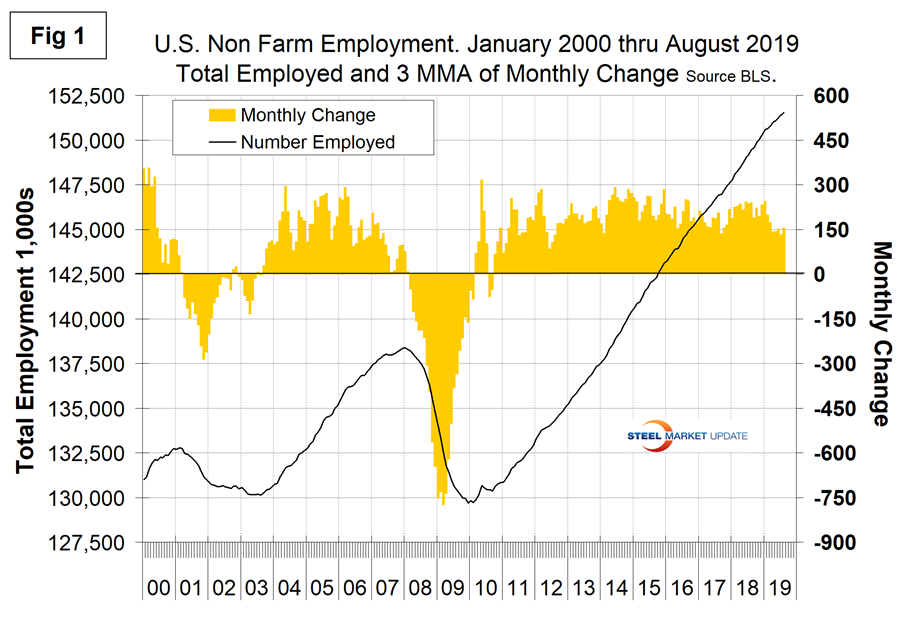
We prefer to use three-month moving averages in our analyses to reduce short-term variability. In averaging employment statistics in this way, we even out what is notoriously volatile data.
Figure 1a shows the raw monthly data since January last year and that the variability in the data has been worse in 2019 than it was last year. The average monthly job creation in the last 20 months has been 188,700.

The employment data has been seasonally adjusted. We have developed Figure 2 to examine if any seasonality is left in the data after adjustment. In the nine years since and including 2011, the average month-on-month change from July to August has been negative 8 percent. This year the change was negative 18 percent, therefore worse than normal. We think it’s significant to look at the results this way because there is so much variability in the numbers that a long-term context is necessary, and it doesn’t look as though the BLS’s seasonal adjustment is very effective.
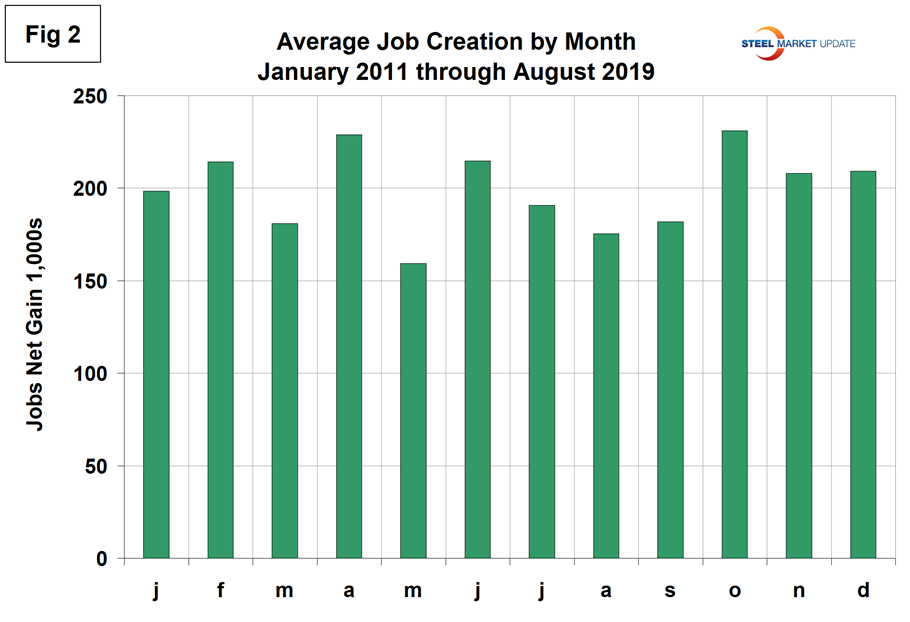
In order to get another look at the degree of change, we have developed Figure 3. This shows the same total employment line as Figure 1, but includes the year-over-year growth on a percentage basis and shows more clearly the steady improvement that occurred during 2018 and the slowdown in 2019. The year-over-year growth of the total number employed has slowed from 1.9 percent in January 2019 to 1.4 percent in August. Considering the variability of the raw monthly data, we think the year-over-year view is the best way to evaluate what’s really going on.
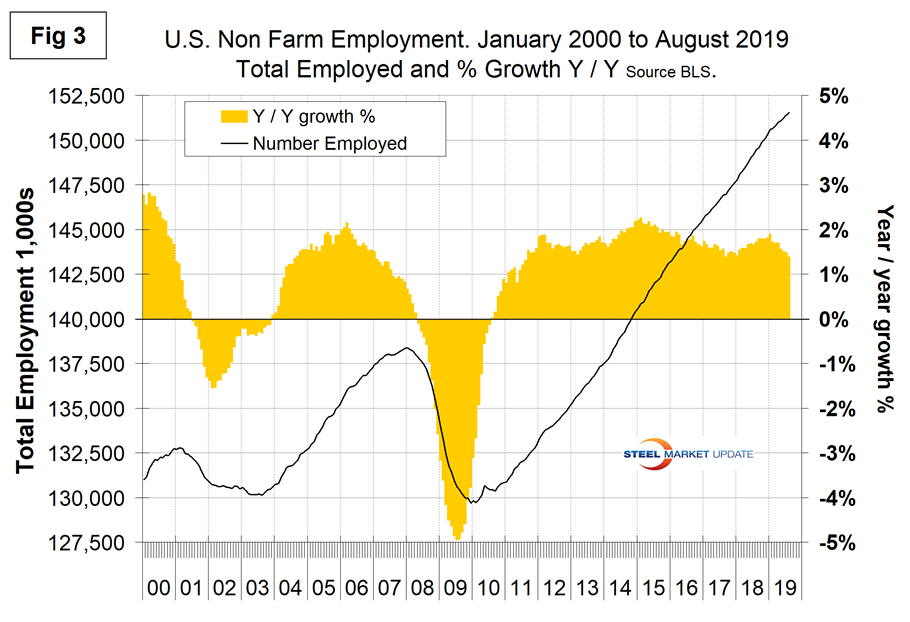
November 2018 was the first month ever for total nonfarm payrolls to exceed 150 million, and in August 2019 was 151.541 million, which was 13.176 million more than the pre-recession high of January 2008.
According to the latest BLS economic news release, average hourly earnings for all employees on private nonfarm payrolls rose by 11 cents in August to $28.11, following 9-cent gains in both June and July. Over the past 12 months, average hourly earnings have increased by 3.2 percent. In August, average hourly earnings of private-sector production and nonsupervisory employees rose by 11 cents to $23.59. The average workweek for all employees on private nonfarm payrolls increased by 0.1 hour to 34.4 hours. In manufacturing, the average workweek increased by 0.2 hour to 40.6 hours, and overtime declined by 0.1 hour to 3.2 hours. The average workweek of private-sector production and nonsupervisory employees increased by 0.1 hour to 33.6 hours.
The official unemployment rate, U3, reported in the BLS Household survey (see explanation below) was unchanged in June, July and August at 3.7 percent. U3 has ranged from 3.6 to 4.0 percent in each of the last 16 months. This is not a very representative number. The more comprehensive U6 unemployment rate at 7.2 percent was down from 8.1 percent in January (Figure 4). The difference between these two measures in August was 3.5 percent. U6 includes individuals working part time who desire full-time work and those who want to work but are so discouraged they have stopped looking.
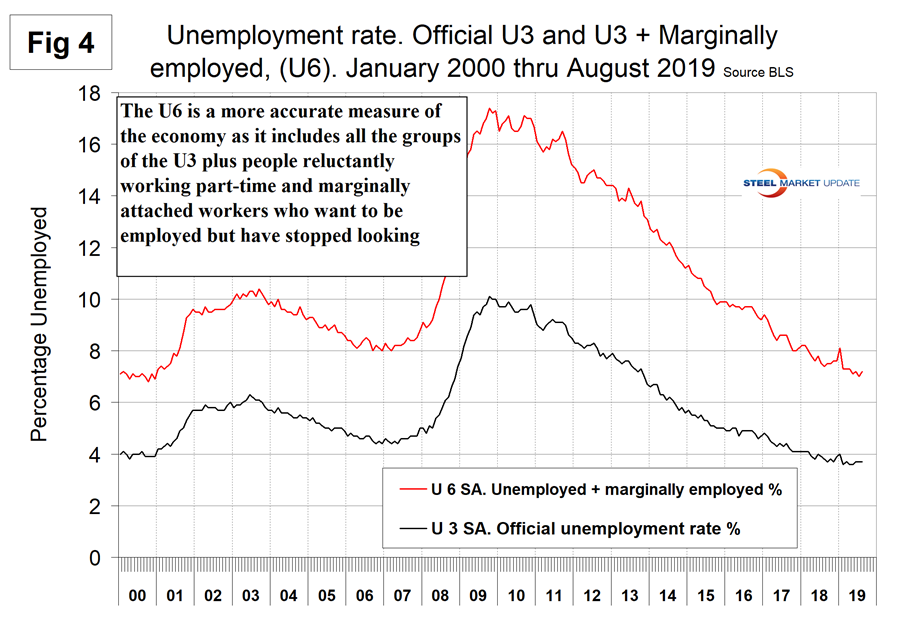
The labor force participation rate is calculated by dividing the number of people actively participating in the labor force by the total number of people eligible to participate. This measure was 63.0 percent in August and hasn’t changed much in three years. Another gauge is the number employed as a percentage of the population, which we think is more definitive. In August, the employment-to-population ratio was 60.9 percent, and has been almost unchanged for 10 months, but has made progress in the last five years. The labor force participation rate has been stalled for three and a half years. Figure 5 shows both measures on one graph.

In the 44 months since and including January 2016, there has been an increase of 8,049,000 full-time and a decrease of 404,000 part-time jobs. Figure 6 shows the rolling 12-month change in both part-time and full-time employment. This data comes from the Household survey and part-time is defined as less than 35 hours per week. Because the full-time/part-time data comes from the Household survey and the headline job creation number comes from the Establishment survey, the two cannot be compared in any given month. To overcome the volatility in the part-time numbers, we look at a rolling 12 months for the full-time and part-time employment picture shown in Figure 6.
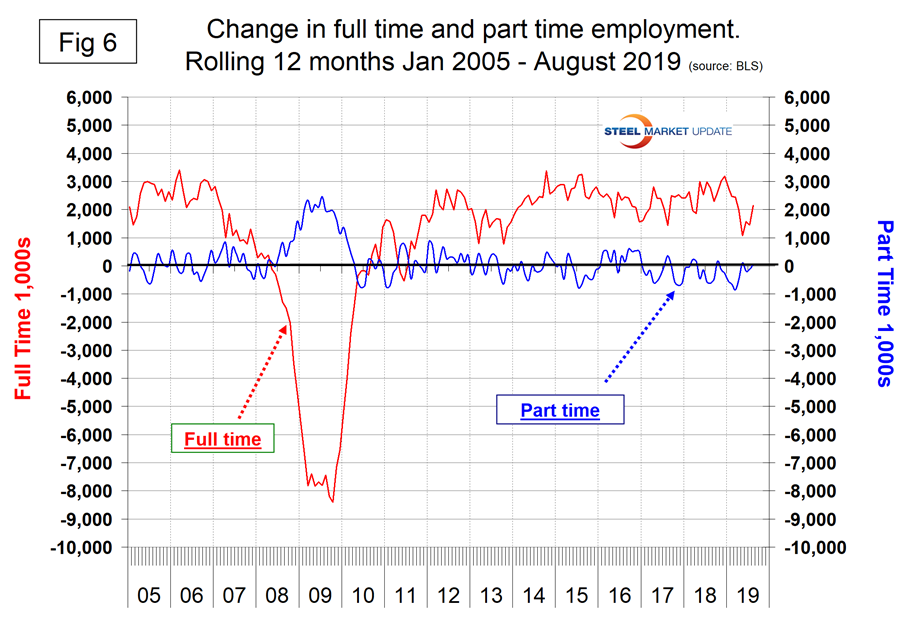
The job openings report known as JOLTS is reported on about the 10th of the month by the Federal Reserve and is more than a month in arrears. In the August employment report, JOLTS data was reported for June. Figure 7 shows the history of unfilled jobs. In June, openings stood at 7,348,000, which was still historically very high. The all-time high was 7,626,000 in November 2018. There are now more job openings than there are people counted as unemployed.

Initial claims for unemployment insurance, reported weekly by the Department of Labor, have been exceptionally low since 2014. The U.S. is enjoying the longest streak since 1973 of initial claims below 300,000 (Figure 8). This data stream is part of our recession outlook report and at present shows no sign of an imminent problem.
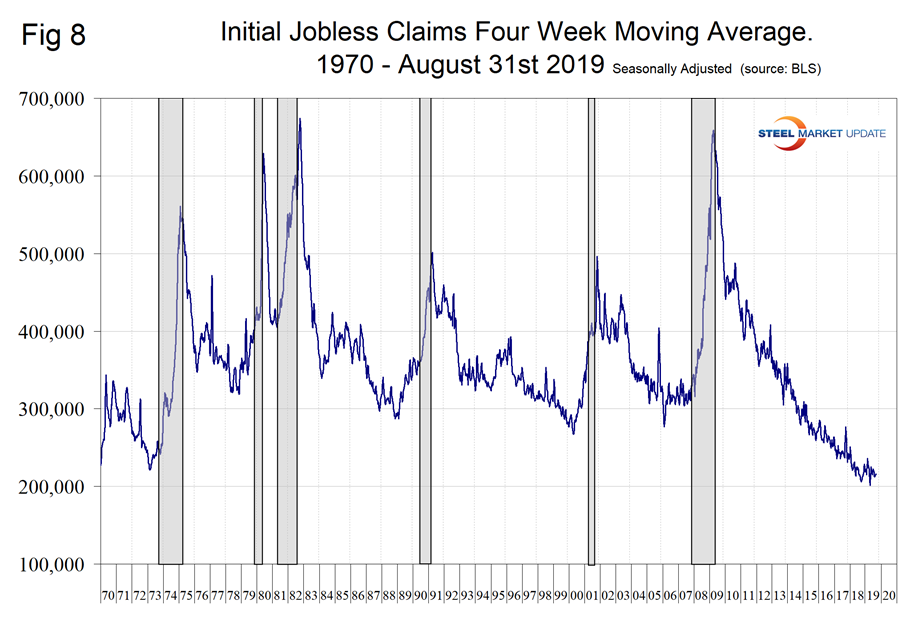
According to the latest Challenger Report, “Job cuts jumped to 53,480 in August, up 39 percent from a year earlier. Firms reported branch closings and trade difficulties as the most prevalent reasons for layoffs. This marks the first time ‘Trade Difficulties’ were listed separately from ‘Tariffs’ as a reason for job cuts. Layoffs were highly concentrated in technology, government and healthcare, which accounted for 49 percent of announced layoffs. Hiring announcements rose modestly compared with a year earlier.”
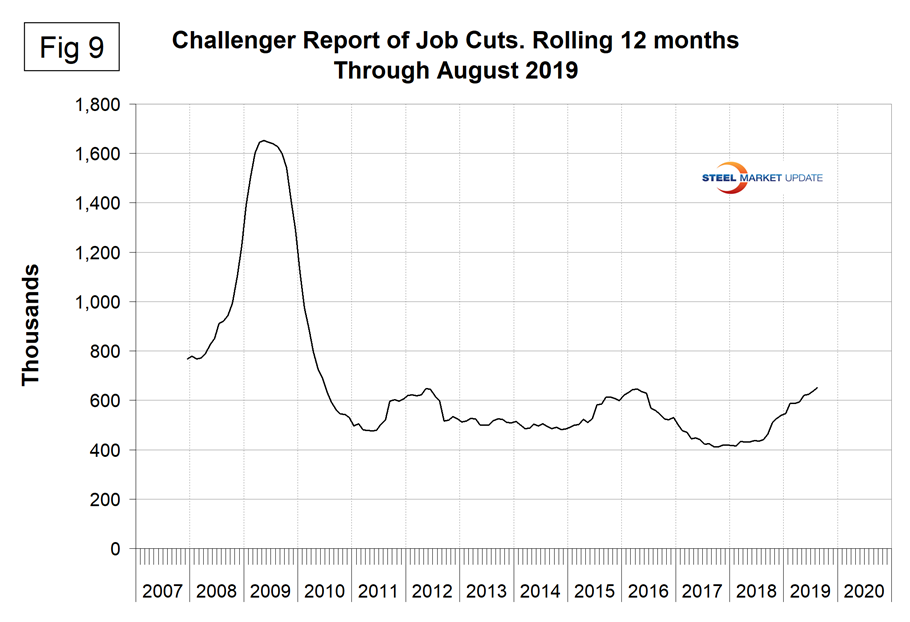
SMU Comment: In assessing the state of the labor market, it is necessary to look at longer time frames than one month because of the extreme volatility of the data. On a three-month moving average basis, job creation has declined from 245,000 in January to 156,000 in August. Job openings are very high and new unemployment claims are very low. Part of the reason for the slowdown in job creation is a lack of qualified applicants at all skill levels, but we don’t know the magnitude of that effect. The upside of the lack of qualified applicants is that the productivity of all U.S. businesses increased by 2.3 percent in the second quarter year over year.
Explanation: On the first Friday of each month, the Bureau of Labor Statistics releases the employment data for the previous month. Data is available at www.bls.gov. The BLS reports on the results of two surveys. The Establishment survey reports the actual number employed by industry. The Household survey reports on the unemployment rate, participation rate, earnings, average workweek, the breakout into full-time and part-time workers and lots more details describing the age breakdown of the unemployed, reasons for and duration of unemployment. At Steel Market Update, we track the job creation numbers by many different categories. The BLS database is a reality check for other economic data streams such as manufacturing and construction. We include the net job creation figures for those two sectors in our “Key Indicators” report. It is easy to drill down into the BLS database to obtain employment data for many subsectors of the economy. For example, among hundreds of sub-indexes are truck transportation, auto production and primary metals production. The important point about all these data streams is the direction in which they are headed. Whenever possible, we try to track three separate data sources for a given steel-related sector of the economy. We believe this gives a reasonable picture of market direction. The BLS data is one of the most important sources of fine-grained economic data that we use in our analyses. The states also collect their own employment numbers independently of the BLS. The compiled state data compares well with the federal data. Every three months, SMU examines the state data and provides a regional report, which indicates strength or weakness on a geographic basis. Reports by individual state can be produced on request.







